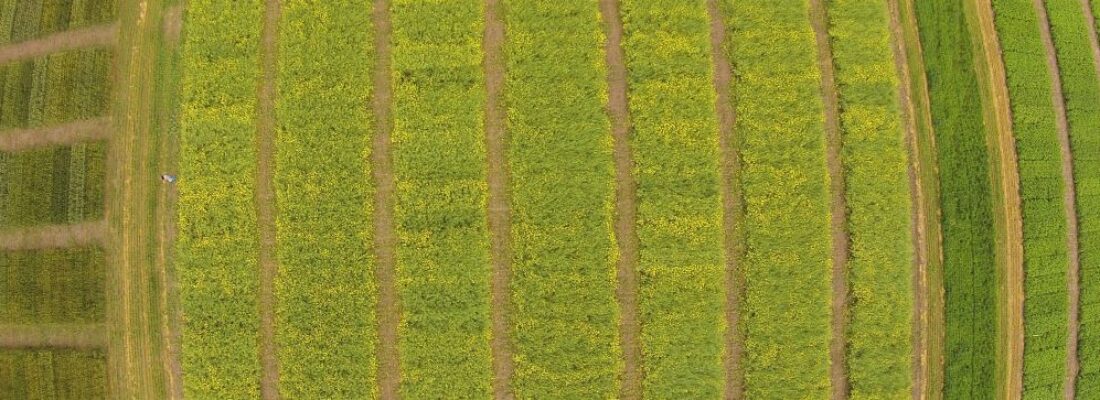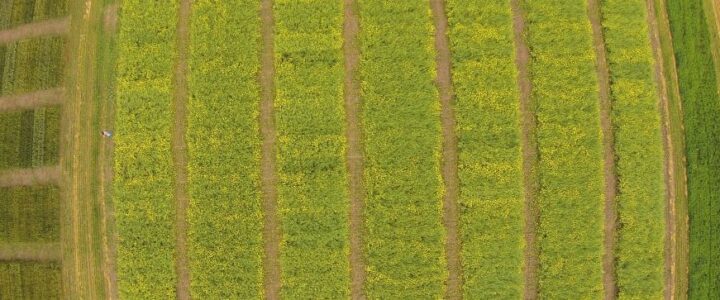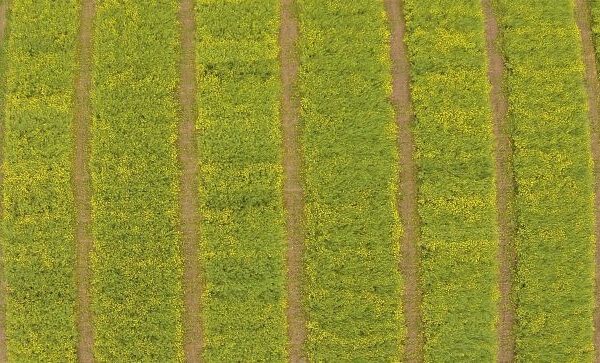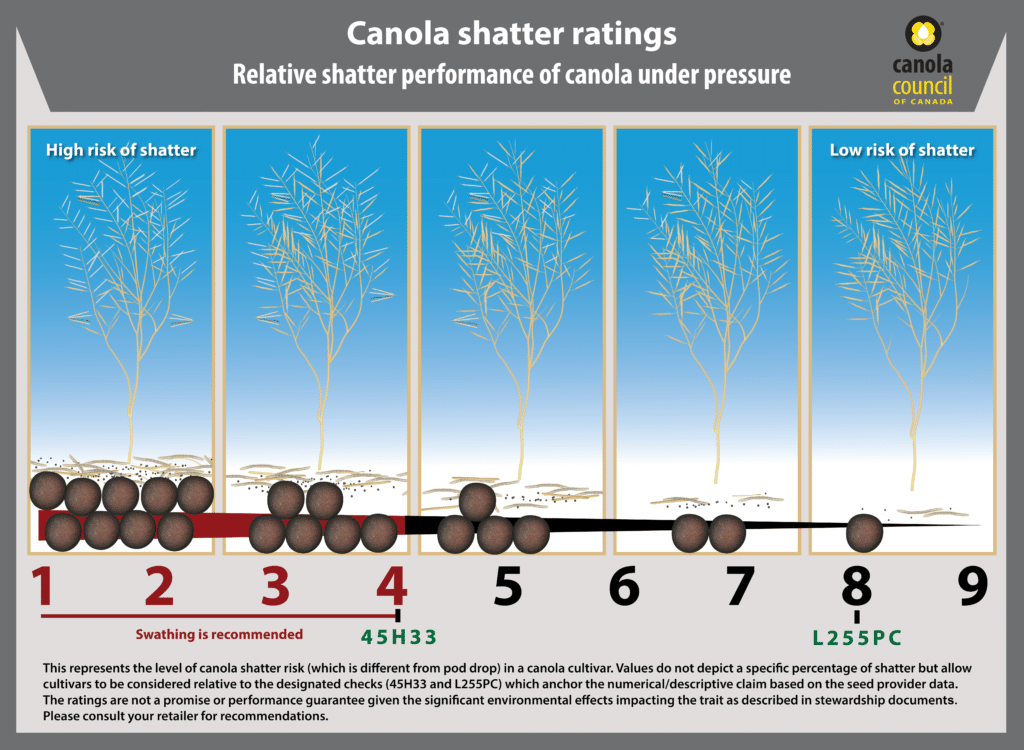Canola breeders continually focus on improvements in canola quality, yield and agronomic characteristics. While some genetic improvements may contribute to yield potential or yield stability across environmental conditions, there are others that reduce the impact of yield-limiting factors, such as resistance to plant diseases. There are also advances that improve the ease of canola production, such as herbicide traits, maturity and harvest management.
Canola labels and ratings
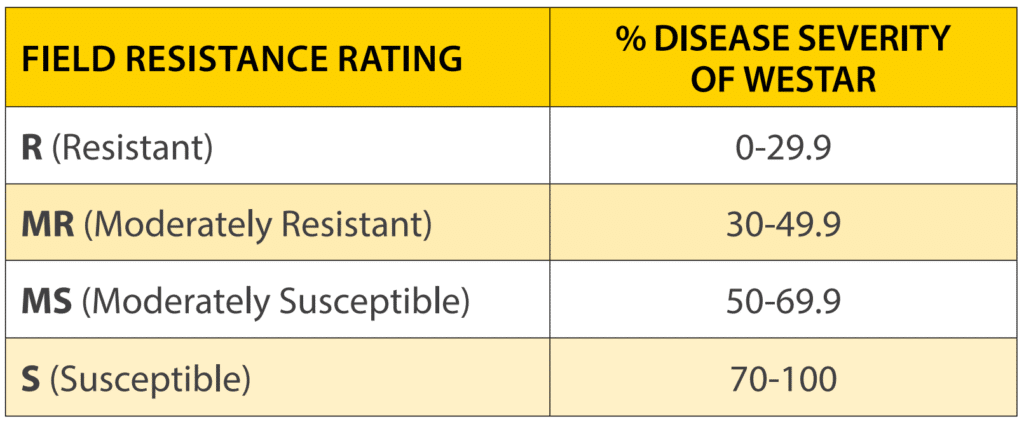
Working through the Western Canada Canola/Rapeseed Recommending Committee (WCC/RRC), canola industry members have aligned to approve standardized procedures to test the average performance of a canola cultivar under disease stress, relative to a fully susceptible cultivar. There are currently official labeling systems on cultivarsCultivars are variants in a species developed through the intervention of humans (despite the term 'variety' often being incorrectly used to describe this). Cultivars can be open-pollinated type, hybrid, synthetic, composite, etc. More for herbicide tolerance, blackleg resistance, clubroot resistance, fusarium wilt resistance and canola shatter.
Individual canola breeding companies substantiate their blackleg resistance claims to the Canadian Food Inspection Agency (CFIA) through standard testing procedures outlined by the WCC/RRC guidelines to obtain blackleg field resistance ratings. CultivarsCultivars are variants in a species developed through the intervention of humans (despite the term 'variety' often being incorrectly used to describe this). Cultivars can be open-pollinated type, hybrid, synthetic, composite, etc. More are compared to the susceptible check cultivar (Westar) for blackleg infection and are assigned ratings of susceptible (S), moderately susceptible (MS), moderately resistant (MR) and resistant (R).

Seed companies can also choose to provide voluntary blackleg resistance group labels on their cultivarsCultivars are variants in a species developed through the intervention of humans (despite the term 'variety' often being incorrectly used to describe this). Cultivars can be open-pollinated type, hybrid, synthetic, composite, etc. More as well. These labels identify the resistance group (RG) based on the major genes in a canola cultivar. Major gene resistance has been categorized into alphabetized groups based on their interactions with the pathogenA disease-causing organism (such as a fungus or bacteria). More and other major genes. It appears after the field resistance label in the two-part label. While 15 major gene resistance groups have been identified, currently only 10 are relevant to Canadian canola producers and are therefore included in the groups.

Understanding Clubroot Resistance guide
There are also official labels for clubroot disease resistance in canola cultivarsCultivars are variants in a species developed through the intervention of humans (despite the term 'variety' often being incorrectly used to describe this). Cultivars can be open-pollinated type, hybrid, synthetic, composite, etc. More. Individual companies substantiate their clubroot resistance claims to the CFIA through standard testing procedures outlined in the WCC/RRC guidelines and through other protocols that are deemed acceptable to the CFIA. CultivarsCultivars are variants in a species developed through the intervention of humans (despite the term 'variety' often being incorrectly used to describe this). Cultivars can be open-pollinated type, hybrid, synthetic, composite, etc. More are compared to the susceptible check cultivarsCultivars are variants in a species developed through the intervention of humans (despite the term 'variety' often being incorrectly used to describe this). Cultivars can be open-pollinated type, hybrid, synthetic, composite, etc. More for clubroot infection and are assigned either resistant (R), intermediate (I) or susceptible (S) ratings.
The canola industry continues to work toward reaching consensus on standardized protocols/methods for other canola diseases, including sclerotinia stem rot and verticillium stripe.
The canola industry members also worked together in 2021-2022 to develop a harmonized rating scale which evaluate canola shatter ratings. The official canola shatter ratings of 1-9 represent the level of canola shatter risk in a canola cultivar, relative to designated check cultivarsCultivars are variants in a species developed through the intervention of humans (despite the term 'variety' often being incorrectly used to describe this). Cultivars can be open-pollinated type, hybrid, synthetic, composite, etc. More (45H33 and L255PC) which anchor the numerical/descriptive claim based on the seed provider data. The values do not depict a specific percentage of shatter and are not a promise or performance guarantee given the significant environmental effects impacting the trait as described in stewardship documents.
With the practice of straight cutting increasing over time and ongoing concern for weather conditions impacting pod shatter characteristics in canola, significant breeding efforts have been put toward pod shatter resistance.
The following table provides the blackleg, clubroot and canola shatter resistance ratings for commercial canola cultivarsCultivars are variants in a species developed through the intervention of humans (despite the term 'variety' often being incorrectly used to describe this). Cultivars can be open-pollinated type, hybrid, synthetic, composite, etc. More available for the 2023 growing season. Please refer to the information below for more information.
Current canola cultivar trait labels
Official blackleg, clubroot, shatter resistance and herbicide tolerance labels on canola cultivars for 2025
*Contains clubroot resistance trait different from or in addition to 1st generation/Mendel. Consult seed representatives for more details.
**Shatter score to be finalized after 2024 season.
Herbicide tolerance is indicated as LL – LibertyLink, TF – TruFlex, RR – Roundup Ready, CL – Clearfield and GLY = Optimum Gly
Additional information
To learn more:
- See Blackleg.ca for the blackleg disease severity scale, to better understand the disease cycle and for blackleg management guides and information.
- See Clubroot.ca to better understand the disease cycle, to learn about dispersal and affected areas and for helpful management information.
- See CanolaHarvestManagement.ca for more information on canola shatter ratings, pod drop and various canola harvest management topics.
Avoid the “no-grow” list
As noted in the Keep it Clean initiative, to mitigate risk, de-registered canola varieties (cultivarsCultivars are variants in a species developed through the intervention of humans (despite the term 'variety' often being incorrectly used to describe this). Cultivars can be open-pollinated type, hybrid, synthetic, composite, etc. More) should not be seeded and seed produced from them should not be delivered to any elevator or grain handler. The “no-grow” list is provided on the Keep it Clean website, along with a link to the full list of de-registered varieties. For more information, visit CFIA’s database of registered varieties and proposed list of variety registration cancellations.
